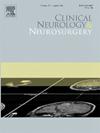Revision surgery for proximal junctional failure: A single-center analysis
IF 1.8
4区 医学
Q3 CLINICAL NEUROLOGY
引用次数: 0
Abstract
Background
Proximal junctional kyphosis (PJK) is a radiographic complication following adult spinal deformity (ASD) surgery due to degeneration of mobile segments adjacent to fused spine. Proximal junctional failure (PJF) represents PJK with structural failure, neurologic deficit, or mechanical instability warranting revision with extension of fusion above the uppermost instrumented vertebra (UIV). This study investigates the clinical presentation, mechanisms of failure, revision strategies, and outcomes for ASD patients who develop PJF after instrumented fusion to the pelvis.
Methods
Fifty-four ASD patients who developed PJF after a posterior instrumented fusion to the pelvis at a single institution from 2009 to 2021 were analyzed. PJF was defined by radiographic PJK with (1) UIV or UIV+1 fracture, UIV screw pullout, or soft-tissue posterior ligamentous disruption, and (2) neurological deficit at presentation.
Results
The cohort was stratified into upper thoracic (UT, 10 patients, T2-T6), lower thoracic (LT, 35 patients, T8-T11), and lumbar (L, 9 patients, L1-L3) spine UIV groups based on index surgery. Patients developed PJF at a median of 14 months (mean 18 ± 16, range: 1–78) after their index surgery. Neurological deficits at presentation included radiculopathy (61 %), myelopathy (48 %), motor deficits (33 %), and bowel or bladder incontinence (9 %). Mechanisms of PJF were vertebral fracture and screw pullout (UT: 50 %, LT: 80 %, L: 89 %, P < 0.001) or soft-tissue disruption (UT: 50 %, LT: 20 %, L: 11 %, P = 0.089) at the UIV. Revision surgery commonly involved posterior column osteotomies (63 %) rather than three-column osteotomies (9 %). Of patients in the UT group, 40 % were extended above the cervicothoracic junction. In the LT and L groups, 91 % and 89 % of patients were extended to the UT and LT spine, respectively. Median follow-up for the cohort after revision for PJF was 24 months (range: 2–89). A total of 26 patients (48 %) required a second revision surgery (median 14 months, range: 1–50), 16 of whom (28 %) were revised for recurrent PJF. Patient-specific and radiographic risk factors for recurrent PJF could not be elucidated.
Conclusion
In this series of ASD patients, after revision for PJF, recurrent PJF was the most common complication requiring another revision. Junctional failures tended to be vertebral body fracture and screw pullout in the LT and L spine and soft tissue disruption in the UT spine. Most revisions involved posterior column osteotomies with proximal extension across the thoracolumbar junction or apex of thoracic kyphosis (e.g., L to LT, LT to UT); notably, nearly half of UT failures were not extended to the cervical spine. Future research is warranted to elucidate risk factors for recurrent PJF and potential preventative strategies.
近端连接功能衰竭的翻修手术:单中心分析
近端交界性后凸(PJK)是成人脊柱畸形(ASD)手术后由于融合脊柱附近的活动节段退变引起的影像学并发症。近端连接失败(PJF)代表PJK伴有结构失败、神经功能缺损或机械不稳定,需要在最上固定椎体(UIV)上方扩展融合翻修。本研究探讨了ASD患者骨盆内固定融合术后发生PJF的临床表现、失败机制、翻修策略和结果。方法对2009年至2021年同一医院54例后路骨盆内固定融合术后发生PJF的ASD患者进行分析。PJF的定义是影像学上的PJK伴有(1)UIV或UIV+1骨折,UIV螺钉拔出或软组织后韧带断裂,(2)出现时神经功能缺损。结果该队列根据指数手术分为上胸椎(UT, 10例,T2-T6)、下胸椎(LT, 35例,T8-T11)和腰椎(L, 9例,L1-L3)脊柱UIV组。患者在指数手术后中位14个月(平均18 ± 16,范围:1-78)发生PJF。神经功能障碍包括神经根病(61 %)、脊髓病(48 %)、运动障碍(33 %)和肠或膀胱失禁(9 %)。机制PJF椎骨折和螺钉撤军(UT: 50 %,LT: 80 % L: 89 % P & LT; 0.001)或软组织破坏(UT: 50 %,LT: 20 %,李:11 % P = 0.089)UIV。翻修手术通常涉及后柱截骨术(63% %)而不是三柱截骨术(9% %)。在UT组患者中,40% %延伸至颈胸交界处以上。在LT组和L组中,分别有91% %和89% %的患者延伸到UT和LT脊柱。修订后PJF队列的中位随访时间为24个月(范围:2-89)。共有26例患者(48 %)需要第二次翻修手术(中位14个月,范围:1-50),其中16例(28 %)因复发性PJF而翻修。复发性PJF的患者特异性和影像学危险因素尚不清楚。结论在本系列ASD患者中,PJF翻修后,复发性PJF是最常见的并发症,需要再次翻修。连接失败往往是椎体骨折和螺钉拔出在LT和L脊柱和软组织破坏在UT脊柱。大多数修复包括后柱截骨术,近端延伸至胸腰椎连接处或胸后凸顶点(例如,L到LT, LT到UT);值得注意的是,近一半的UT失败没有扩展到颈椎。未来的研究需要阐明复发性PJF的危险因素和潜在的预防策略。
本文章由计算机程序翻译,如有差异,请以英文原文为准。
求助全文
约1分钟内获得全文
求助全文
来源期刊

Clinical Neurology and Neurosurgery
医学-临床神经学
CiteScore
3.70
自引率
5.30%
发文量
358
审稿时长
46 days
期刊介绍:
Clinical Neurology and Neurosurgery is devoted to publishing papers and reports on the clinical aspects of neurology and neurosurgery. It is an international forum for papers of high scientific standard that are of interest to Neurologists and Neurosurgeons world-wide.
 求助内容:
求助内容: 应助结果提醒方式:
应助结果提醒方式:


